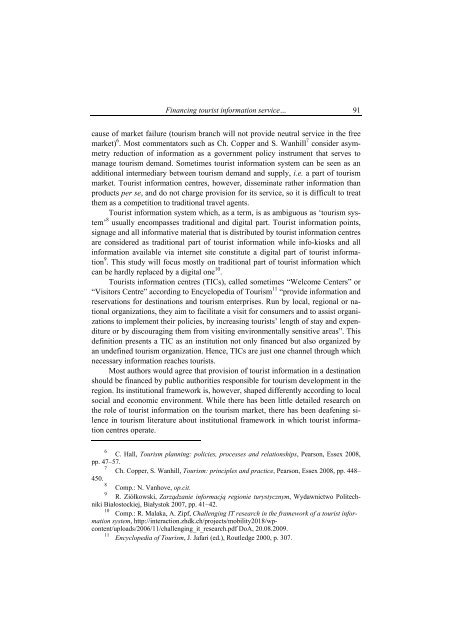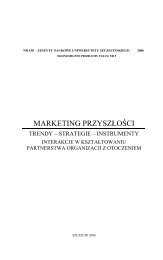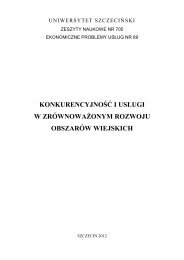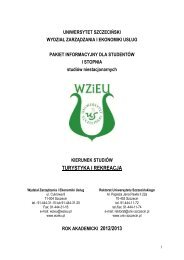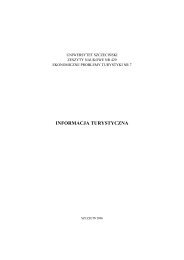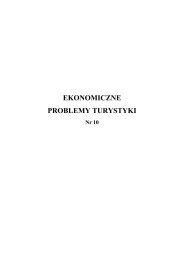Zeszyt naukowy - caÅoÅÄ - WydziaÅ ZarzÄ dzania i Ekonomiki UsÅug
Zeszyt naukowy - caÅoÅÄ - WydziaÅ ZarzÄ dzania i Ekonomiki UsÅug
Zeszyt naukowy - caÅoÅÄ - WydziaÅ ZarzÄ dzania i Ekonomiki UsÅug
You also want an ePaper? Increase the reach of your titles
YUMPU automatically turns print PDFs into web optimized ePapers that Google loves.
Financing tourist information service… 91<br />
cause of market failure (tourism branch will not provide neutral service in the free<br />
market) 6 . Most commentators such as Ch. Copper and S. Wanhill 7 consider asymmetry<br />
reduction of information as a government policy instrument that serves to<br />
manage tourism demand. Sometimes tourist information system can be seen as an<br />
additional intermediary between tourism demand and supply, i.e. a part of tourism<br />
market. Tourist information centres, however, disseminate rather information than<br />
products per se, and do not charge provision for its service, so it is difficult to treat<br />
them as a competition to traditional travel agents.<br />
Tourist information system which, as a term, is as ambiguous as ‘tourism system’<br />
8 usually encompasses traditional and digital part. Tourist information points,<br />
signage and all informative material that is distributed by tourist information centres<br />
are considered as traditional part of tourist information while info-kiosks and all<br />
information available via internet site constitute a digital part of tourist information<br />
9 . This study will focus mostly on traditional part of tourist information which<br />
can be hardly replaced by a digital one 10 .<br />
Tourists information centres (TICs), called sometimes “Welcome Centers” or<br />
“Visitors Centre” according to Encyclopedia of Tourism 11 “provide information and<br />
reservations for destinations and tourism enterprises. Run by local, regional or national<br />
organizations, they aim to facilitate a visit for consumers and to assist organizations<br />
to implement their policies, by increasing tourists’ length of stay and expenditure<br />
or by discouraging them from visiting environmentally sensitive areas”. This<br />
definition presents a TIC as an institution not only financed but also organized by<br />
an undefined tourism organization. Hence, TICs are just one channel through which<br />
necessary information reaches tourists.<br />
Most authors would agree that provision of tourist information in a destination<br />
should be financed by public authorities responsible for tourism development in the<br />
region. Its institutional framework is, however, shaped differently according to local<br />
social and economic environment. While there has been little detailed research on<br />
the role of tourist information on the tourism market, there has been deafening silence<br />
in tourism literature about institutional framework in which tourist information<br />
centres operate.<br />
6<br />
C. Hall, Tourism planning: policies, processes and relationships, Pearson, Essex 2008,<br />
pp. 47–57.<br />
7<br />
Ch. Copper, S. Wanhill, Tourism: principles and practice, Pearson, Essex 2008, pp. 448–<br />
450.<br />
8<br />
Comp.: N. Vanhove, op.cit.<br />
9<br />
R. Ziółkowski, Zarządzanie informacją regionie turystycznym, Wydawnictwo Politechniki<br />
Białostockiej, Białystok 2007, pp. 41–42.<br />
10<br />
Comp.: R. Malaka, A. Zipf, Challenging IT research in the framework of a tourist information<br />
system, http://interaction.zhdk.ch/projects/mobility2018/wpcontent/uploads/2006/11/challenging_it_research.pdf<br />
DoA, 20.08.2009.<br />
11<br />
Encyclopedia of Tourism, J. Jafari (ed.), Routledge 2000, p. 307.


